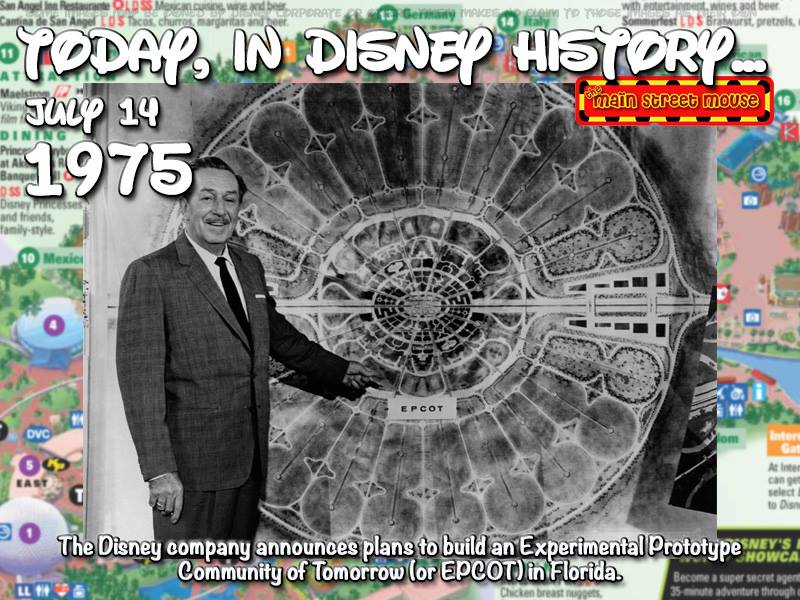Today In Disney History ~ July 14th
The Experimental Prototype Community of Tomorrow (EPCOT) was an unfinished concept being developed by Walt Disney. Its purpose was to be a “real city that would ‘never cease to be a blueprint of the future,'” designed to stimulate American corporations to come up with new ideas for urban living. This was part of Walt Disney’s original plan for the property purchased near Orlando, Florida, but after his death in 1966, the property became the Walt Disney World Resort in 1971
and a theme park based on the idea opened in 1982. A portion of the original architectural model of the concept can be viewed on the Tomorrowland Transit Authority PeopleMover in the Magic Kingdom.
In the early 1960s, entertainment industry magnate Walt Disney, who by this time had many grandchildren, began to worry about the future of the world they would inhabit. He worried especially about modern cities, which he believed were hectic, disorganized, dirty, and crime-ridden, a far cry from his clean and controlled Disneyland Park in California. Realizing that what he and his Imagineers had learned in the development of Disneyland could be put to use in planning communities, and perhaps even cities, Disney began to immerse himself in books about city planning, such as Ebenezer Howard’s Garden Cities of To-morrow. Around the same time, Disney had given the East Coast a glimpse of his style of entertainment, with the four pavilions he developed for the 1964-1965 New York World’s Fair. The success of these exhibitions convinced him that the time was right for an “East Coast Disneyland”. (See Great Moments with Mr. Lincoln, Carousel of Progress, It’s A Small World) However, Disney did not want simply to build a second Disneyland. He wanted to create something entirely different: a community for people to live in.
Walt Disney determined that Florida was the best location for his new project. Through various dummy corporations, he purchased 27,800 acres (113 km2) of Florida swampland located between Orlando and Kissimmee. Commenting on this choice, he said, “Here in Florida we’ve enjoyed something we’ve never enjoyed at Disneyland: the blessing of size. There’s enough land here to hold all the ideas and plans we could possibly imagine”. Disney also petitioned the Florida State Legislature to give Walt Disney Productions municipal jurisdiction over the land they had acquired. This ensured that Walt Disney would have full control over every aspect of the development of the property, including building construction. The jurisdiction thus created eventually became known as the Reedy Creek Improvement District.
A recording on October 27, 1966, less than two months before Disney’s death, was a 25-minute film about his plans for the Florida Project, then dubbed “Disney World”. In the film, Walt himself explains briefly how the Florida property will be utilized and how his EPCOT concept will work with the other aspects of Disney World. Disney made this film primarily to persuade and encourage American industry and various corporations to opt in and help Walt Disney Productions in the creation and running of EPCOT. Disney also encouraged the industrial companies to come up with their best ideas in technology, so that those ideas could be continuously demonstrated in the city. With the help of concept art and animation, Disney showed what the city would look like and how it would work. However, he reminded the viewing audience that the sketches and paintings are only a starting point in the conceptualization of EPCOT, stating: “Everything in this room will change time and time again as we move ahead. But the basic philosophy of what we’re planning for Disney World is going to remain very much as it is right now”. The film itself can be found on Walt Disney Treasures – Tomorrow Land in its entirety.
The Carousel of Progress was one of Walt Disney’s attractions developed for the New York’s World Fair in 1963-64. Guests stayed in their seats as an outer ring of six theaters moved around a fixed, circular section. While guests were entering into one theater and exiting from another, guests in the other four theaters were watching the tireless Audio-Animatronic actors in the four acts of the show depicting the evolution of the science and technology in our life through the eyes of the same family. When the Fair ended, Walt Disney had a perfect attraction to export to Disneyland. Walt Disney died in December 1966. He never saw the July 1967 re-opening of the attraction this time at Disneyland. In Disneyland, the show concluded with a fifth act, featuring the detailed model of what was known as Progress City. This city was the preview of Walt’s vision for Epcot. Extremely detailed, the model features all of the major key elements of his project:
- the radial design
- the urban center and its towering hotel
- the green belt
- the industrial park
- the Monorails and PeopleMovers
The Carousel of Progress closed its doors in 1973 and was moved to Walt Disney World at the Magic Kingdom in 1975. The model of Progress City (Epcot) was not included in the Floridian version and a very reduced and less animated version of the model was put on display along the tracks of the PeopleMover where it remains to this day. The model on display is in fact only a small section of the original model (mostly the urban center and the greenbelt) and most of the detailed animations are now turned off, only the internal lighting is being maintained.
 TMSM Today in Graphic by Sherry Rinaldi DeHart; Wiki
TMSM Today in Graphic by Sherry Rinaldi DeHart; Wiki - EPCOT Food & Wine Fest Dates, Details Announced - April 23, 2024
- Daydream Believing! - April 19, 2024
- Disney Adventure World: Disneyland Paris Reimagines 2nd Park - April 12, 2024




